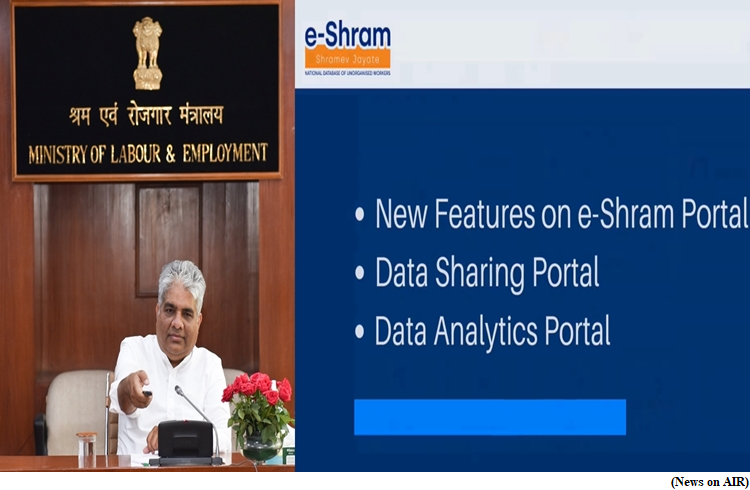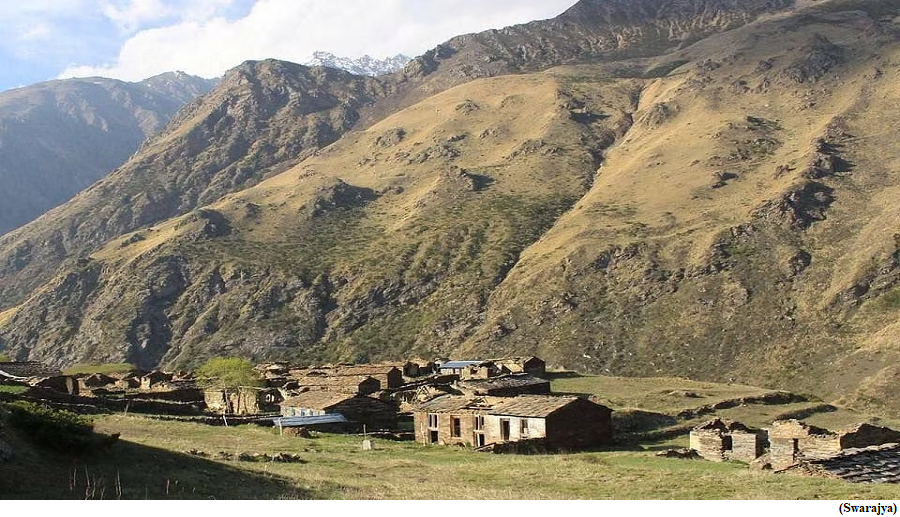New features in eShram Portal launched (GS Paper 2, Governance)

Why in news?
- Recently, the Union Minister for Labour & Employment launched new features in eShram Portal.
Key Highlights:
- The new features added in eShram portal will enhance the utility of the portal and facilitate ease of registration for unorganised workers.
- The eShram registered workers can now connect with Employment opportunities, Skilling, Apprenticeship, Pension Scheme, Digital Skilling and States’ schemes through eShram portal.
- A feature of capturing family details of migrant worker has been added to the eShram portal. This feature can help in providing Child education and women centric schemes to the migrant workers who have migrated with family.
- Further, a new feature on sharing of data of construction workers registering on eShram with the concerned Building and Other Construction Workers’ (BOCW) Welfare Board, has been added to ensure registration of eShram construction workers with the respective BOCW board and access to the schemes meant for them.
Data Sharing Portal (DSP):
- He also formally launched Data Sharing Portal (DSP) for sharing of eShram data with the State/ UT Governments.
- Data Sharing Portal will allow sharing of eShram beneficiaries data with the respective States and Union Territories in a secured manner for targeted implementation of social security/welfare schemes for the unorganised workers registered on eShram.
- Recently, Ministry initiated mapping of different schemes data with eShram data to identify the eShram registrants who have not yet received the benefits of these schemes.
- This data is also being shared with States/UTs based on which, States/UTs can identify unorganised workers who have not yet received benefit of the social welfare/security schemes and provide schemes’ benefit to them, on priority.
About eShram portal:
- The Ministry of Labour & Employment launched eShram portal on 26th August 2021 to create a comprehensive National Database of Unorganised Workers which is seeded with Aadhaar.
- As on 21st April 2023, over 28.87 crore unorganised workers have registered on eShram portal.
India braces to evacuate nationals from Sudan
(GS Paper 2, International Relation)
Why in news?
- Recently, India has started Operation Kaveri to evacuate its nationals from conflict-torn Sudan.
- Nearly 3,000 Indians are stuck in various parts of Sudan, including the national capital, Khartoum, and distant provinces such as Darfur.

Why named as ‘Operation Kaveri’?
- The Choice of naming this operation as 'Operation Kaveri' has a lot of significance.
- The Kaveri is one of the major Indian rivers flowing through the southern states of Karnataka and Tamil Nadu. The river is sacred to the people of the region and is worshipped as the Goddess Kaveriamma (mother Kaveri).
- Rivers reach their destination irrespective of barriers. It's like a mother who will ensure she will bring her children back to safety.
Recent events:
- India had earlier stationed two C-130J heavy-lift aircraft in Jeddah and sent INS Sumedha to Port Said for the operation.
- The evacuation acquired urgency in view of the total breakdown of essential services in Sudan. Food and water are in short supply, and there is power outage.
- Indians in the region have reached out to the government, showing videos of indiscriminate attacks that also targeted residences of the Indian community and looting of essential items by the rebel paramilitary.
Background:
- The political crisis in Sudan turned into a countrywide armed conflict on April 15 after a disagreement between the paramilitary Rapid Support Forces (RSF) and the Sudanese Armed Forces (SAF) over the Security Sector Reform (SSR) spiralled into an armed confrontation between the commanders of the two wings.
- The conflict left hundreds of Indians stranded at the airport in Khartoum. They subsequently took shelter in nearby hotels as fighting intensified.
Vibrant Villages plan to be merged with PM Gati Shakti
(GS Paper 2, Governance)
Why in news?
- The Centre’s ambitious Vibrant Villages Programme (VVP), which aims to develop infrastructure and open up villages along the China border to tourists, will be integrated with the Prime Minister’s Gati Shakti mega project.
- The digital platform of the Gati Shakti project brings 16 Ministries, including Railways and Highways, together for integrated planning and coordinated implementation of infrastructure connectivity projects and allows departments to break operational silos.

Integration with BISAG-N:
- The Bhaskaracharya National Institute for Space Applications and Geoinformatics (BISAG-N) in Gujarat has been roped in to provide satellite images and GIS mapping of the projects that will be taken up under the scheme.
- BISAG-N will be tracking the infrastructure and other land-use changes in the border villages for real-time monitoring.
Objective:
- One of the objectives of the Vibrant Villages Programme is to stop migration of border population.
- The objective is to motivate people to continue to stay there and it will also help to gather intelligence from the people of border villages.
Background:
- On February 15, the Union Cabinet approved the programme to cover 2,967 villages in 46 border blocks of 19 districts in four States and one Union Territory along the China border. Of these, 662 villages will be prioritised for coverage.
- The scheme has been allocated ₹4,800 crore for the financial years 2023-24, 2024-25 and 2025-26. The amount allocated for road construction is ₹2,500 crore.




